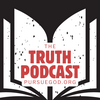338 episodes

Secrets for a Fruitful Life
2025/12/29 | 32 mins.
Welcome back to the podcas, as we close out this year with a special New Year's episode!--The PursueGOD Truth podcast is the “easy button” for making disciples – whether you’re looking for resources to lead a family devotional, a small group at church, or a one-on-one mentoring relationship. Join us for new episodes every Tuesday and Friday. Find resources to talk about these episodes at pursueGOD.org.Help others go "full circle" as a follower of Jesus through our 12-week Pursuit series.Click here to learn more about how to use these resources at home, with a small group, or in a one-on-one discipleship relationship.Got questions or want to leave a note? Email us at [email protected] Now--Every new year brings a familiar pressure: do more, be better, try harder. But on the night before His crucifixion, Jesus offered His disciples something radically different. In a moment filled with uncertainty, anxiety, and transition, He revealed the true secrets to a fruitful life—not through striving, but through connection.A Moment of TransitionJohn 15 isn’t a traditional “New Year’s passage,” but it may be the most important chapter for stepping into a new season. Jesus and His disciples are in the Upper Room. He has washed their feet. They’ve shared the Last Supper. Judas has already left. The weight of what’s coming hangs heavy in the air.This moment feels like a final speech—Jesus preparing His closest followers for life without His physical presence. Twice in John 14, He tells them not to let their hearts be troubled or afraid. And yet, they clearly are.We can relate. None of us knows what awaits us in the coming year. We don’t know what challenges, changes, or losses might be ahead. So how can we live without fear? Jesus answers that question in John 15.Secret #1: Think Like a Producer, Not a ConsumerJesus begins with a metaphor:John 15:1–2 (NLT) – “I am the true grapevine, and my Father is the gardener. He cuts off every branch of mine that doesn’t produce fruit, and he prunes the branches that do bear fruit so they will produce even more.”The disciples were likely confused. They were focused on themselves—Why are you leaving us? Why can’t we go with you? But Jesus flips the perspective. He shifts the focus outward.Fruitfulness isn’t about self-improvement; it’s about impact.A consumer mindset asks, What do I get out of this?A producer mindset asks, What can God do through me?This changes everything—our marriages, our parenting, our work, our church involvement. Instead of seeing ourselves as victims of circumstances, we begin asking how we can bring peace, serve others, and make disciples. Jesus had just modeled this by washing His disciples’ feet.A fruitful life starts when we stop making it all about us.Secret #2: Stay Connected to the VineJesus continues:John 15:4–5 (NLT) – “Remain in me, and I will remain in you… For apart from me you can do nothing.”The image is organic, not mechanical. Branches don’t strive to produce fruit; they simply stay connected. This runs counter to how we’re wired. We’re taught to maximize effort, build better habits, and dig deeper into ourselves.But Jesus says fruit comes from abiding—learning the art of being with Him.That’s harder than it sounds. Many of us are good at doing things for God, but not being with God. Remaining requires intentional...

The Christmas Family Tree: We Three Kings
2025/12/21 | 33 mins.
Welcome back to the podcast! Today, we are in week two of our Christmas series!--The PursueGOD Truth podcast is the “easy button” for making disciples – whether you’re looking for resources to lead a family devotional, a small group at church, or a one-on-one mentoring relationship. Join us for new episodes every Tuesday and Friday. Find resources to talk about these episodes at pursueGOD.org.Help others go "full circle" as a follower of Jesus through our 12-week Pursuit series.Click here to learn more about how to use these resources at home, with a small group, or in a one-on-one discipleship relationship.Got questions or want to leave a note? Email us at [email protected] Now--WE THREE KINGS: A ROYAL MESS AND A FAITHFUL GODMost of us skim past the first seventeen verses of the New Testament. The long list of names in Matthew’s genealogy feels distant and hard to pronounce, so we move on quickly. But Matthew didn’t include those names by accident. He placed them there to ground the Christmas story in real history. Jesus didn’t drop out of the sky. He entered the world through a real family—full of faith, failure, courage, compromise, and grace.Matthew organizes Jesus’ family tree into three groups of fourteen generations. First come the patriarchs, from Abraham to David—the rise of a family. Then come the kings, from David to the exile—the ruin of a kingdom. Finally comes the remnant, from the exile to Jesus—the long road toward restoration. Last week we looked at the outsiders in Jesus’ lineage: Tamar, Rahab, and Ruth. This week we turn to the kings.You might expect the kings to be the highlight reel—strong leaders, noble faith, spiritual consistency. Instead, what we find is a royal mess. To understand it, we’ll look at three kings from the southern kingdom of Judah: a father, a son, and a grandson. Their stories show how faith can be passed down, rejected, reclaimed, and lost again.King Ahaz: The Shadow of a Bad LegacyBy the time Ahaz became king, Israel was divided. The northern kingdom had fully embraced wickedness. Judah, the southern kingdom—where Jesus’ line continued—was struggling to stay faithful. Ahaz did not help.2 Kings 16:2–3 (NLT) tells us that Ahaz “did not do what was pleasing in the sight of the Lord… Instead, he followed the example of the kings of Israel, even sacrificing his own son in the fire.”In the ancient world, people believed that if you wanted the gods to act, you had to give them something valuable. Ahaz was losing a war and terrified of losing his throne. In desperation, he went to the Valley of Ben Hinnom and sacrificed his own son to Molech. That valley later became known as Gehenna—the word Jesus used for hell.Ahaz’s legacy is devastating. He sacrificed his son on the altar of selfishness. Before we judge him too quickly, we should ask an uncomfortable question: What do we sacrifice our children to today? Career success, personal freedom, reputation, comfort, or misplaced ambition can quietly become modern altars.King Hezekiah: The Cycle BreakerAfter Ahaz died, his son Hezekiah took the throne. He grew up surrounded by idolatry. He had watched his father’s choices destroy lives. Everything about his upbringing suggested he would repeat the cycle.But 2 Kings 18:5–7 (NLT) says something remarkable: “Hezekiah trusted in the Lord… There was no one like him among all the kings of Judah.”Hezekiah broke the cycle. He tore down idols—even destroying the bronze serpent Moses had made because people were worshiping it...

The Year-End Episode
2025/12/16 | 11 mins.
In this episode, Bryan wraps up 2025 and gives us a clear snapshot of what God has been doing through PursueGOD—and what’s coming next in 2026.--The PursueGOD Truth podcast is the “easy button” for making disciples – whether you’re looking for resources to lead a family devotional, a small group at church, or a one-on-one mentoring relationship. Join us for new episodes every Tuesday and Friday. Find resources to talk about these episodes at pursueGOD.org.Help others go "full circle" as a follower of Jesus through our 12-week Pursuit series.Click here to learn more about how to use these resources at home, with a small group, or in a one-on-one discipleship relationship.Got questions or want to leave a note? Email us at [email protected] Now --Check out our YouVersion reading plansWant to donate? Click here

The Christmas Family Tree: The Part We Usually Skip
2025/12/14 | 26 mins.
Welcome back to the podcast! Join us today as we start a new Christmas series!--The PursueGOD Truth podcast is the “easy button” for making disciples – whether you’re looking for resources to lead a family devotional, a small group at church, or a one-on-one mentoring relationship. Join us for new episodes every Tuesday and Friday. Find resources to talk about these episodes at pursueGOD.org.Help others go "full circle" as a follower of Jesus through our 12-week Pursuit series.Click here to learn more about how to use these resources at home, with a small group, or in a one-on-one discipleship relationship.Got questions or want to leave a note? Email us at [email protected] Now --The Christmas Family Tree: The Part We Usually SkipMost people love Luke 2 at Christmas—the angels, the shepherds, the manger scene. But few of us slow down for Matthew 1, the chapter that looks like the “skip intro” button of the New Testament. Genealogies feel like the part you breeze through on your Bible-in-a-year plan. Yet Matthew opens the story of Jesus with a family tree on purpose—not to bore us, but to prepare us for what Christmas is really about.Matthew organizes Jesus’ genealogy into three sets of fourteen generations (Matthew 1:1–17). It’s not intended to be exhaustive; it’s designed to make a theological point. Jesus is the promised Son of David, the fulfillment of God’s long-awaited plan. But Matthew also includes something shocking for ancient readers: five women—and three of them appear in the very first section of the genealogy.In the first century, writers didn’t include women in genealogies, and certainly not women with complicated, painful, or morally messy backstories. But Matthew breaks the rules to highlight a truth at the heart of Christmas: God invites outsiders, sinners, strugglers, and the unexpected into His family. These women tell us what kind of Savior Jesus really is—and what kind of grace He brings.TAMAR — The God Who Sees the Hidden StoryMatthew 1:3 (NLT): “Judah was the father of Perez and Zerah (whose mother was Tamar).”Tamar’s story in Genesis 38 is one of the most uncomfortable chapters in the Bible. She marries into Judah’s family, but tragedy and injustice quickly follow. Her first husband dies. The second refuses to fulfill his duty to give her a child. Judah promises his youngest son to her “later,” but he never intends to keep his word.Tamar is left childless, powerless, and trapped in a culture where bearing children was the only path to honor, security, and a future. Judah fails her completely, and out of desperation she takes matters into her own hands—posing as a prostitute to confront Judah’s neglect. When Judah discovers what happened, he responds with a shocking confession:Genesis 38:26 (NLT): “She is more righteous than I am.”This isn’t a story celebrating deception—it’s a story exposing Judah’s injustice. Tamar is the wronged one, and yet God sees her, steps into her story, and brings redemption through the birth of Perez—a direct ancestor of Jesus.The lesson of Tamar:God steps into the stories we try to hide.He doesn’t turn away from the messy parts of our past—He redeems them. Tamar reminds us that God moves toward the abandoned and overlooked with purpose and...

Noemi’s Story: Did I Ever Feel Worthy? - Unveiling Mormonism
2025/12/08 | 41 mins.
In this episode, Bryan talks with Noemi about her journey leaving Mormonism and discovering a relationship with the God of the Bible.--The Unveiling Mormonism podcast pulls back the curtain on Mormon history, culture and doctrine. Join us for new episodes every Monday. Find resources to talk about these episodes at pursueGOD.org/mormonism.Help others go "full circle" as a follower of Jesus through our 12-week Pursuit series.Click here to learn more about how to use these resources at home, with a small group, or in a one-on-one discipleship relationship.Got questions or want to leave a note? Email us at [email protected] Now --
More Education podcasts
Trending Education podcasts
About The PursueGOD Truth Podcast
Listen to The PursueGOD Truth Podcast, Habits of A Goddess and many other podcasts from around the world with the radio.net app

Get the free radio.net app
- Stations and podcasts to bookmark
- Stream via Wi-Fi or Bluetooth
- Supports Carplay & Android Auto
- Many other app features
Get the free radio.net app
- Stations and podcasts to bookmark
- Stream via Wi-Fi or Bluetooth
- Supports Carplay & Android Auto
- Many other app features


The PursueGOD Truth Podcast
download the app,
start listening.






































